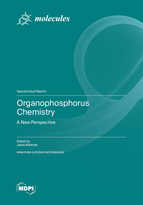Organophosphorus Chemistry: A New Perspective
A special issue of Molecules (ISSN 1420-3049). This special issue belongs to the section "Organic Chemistry".
Deadline for manuscript submissions: closed (30 April 2023) | Viewed by 19921
Special Issue Editor
2. Biotechnology Center of Silesian University of Technology, B. Krzywoustego 8, 44-100 Gliwice, Poland
Interests: organic synthesis; electroorganic synthesis; organophosphorus chemistry; phosphonium salts; amino acids; NMR; IR
Special Issues, Collections and Topics in MDPI journals
Special Issue Information
Dear Colleagues,
Organophosphorus chemistry is undoubtedly important and one of the fastest-growing branches of organic chemistry. It is often said that we are living now in “the golden age of phosphorus chemistry”. In the laboratory, phosphorus-containing compounds (P-compounds) are widely used as reagents (starting materials, precursors of active intermediates such as ylides or iminium-type cations, etc.), catalysts (PTC, organocatalysis), and solvents (PILs). Due to the interesting properties of P-compounds (especially their biological activity), they are used on a large scale in medicine (e.g., bone disorders drugs, anticancer and antiviral agents, or antihelminthics in veterinary applications), agriculture (e.g., pesticides), and industry (e.g., production of lubricants or plastic materials).
However, in the age of much-needed care for the natural environment, we face new challenges. Innovative approaches to the synthesis and isolation of P-compounds (taking into account the aspects of green chemistry and sustainability) followed by responsible use and disposal (neutralization) may prove crucial in the near future.
It is my great pleasure to invite experts in the field of organophosphorus chemistry to submit manuscripts in the form of short communications, full-length papers, and reviews to this Special Issue. I would like to extend a special invitation to young scientists to present their ideas and a fresh approach to the issues related to phosphorus chemistry.
Dr. Jakub Adamek
Guest Editor
Manuscript Submission Information
Manuscripts should be submitted online at www.mdpi.com by registering and logging in to this website. Once you are registered, click here to go to the submission form. Manuscripts can be submitted until the deadline. All submissions that pass pre-check are peer-reviewed. Accepted papers will be published continuously in the journal (as soon as accepted) and will be listed together on the special issue website. Research articles, review articles as well as short communications are invited. For planned papers, a title and short abstract (about 100 words) can be sent to the Editorial Office for announcement on this website.
Submitted manuscripts should not have been published previously, nor be under consideration for publication elsewhere (except conference proceedings papers). All manuscripts are thoroughly refereed through a single-blind peer-review process. A guide for authors and other relevant information for submission of manuscripts is available on the Instructions for Authors page. Molecules is an international peer-reviewed open access semimonthly journal published by MDPI.
Please visit the Instructions for Authors page before submitting a manuscript. The Article Processing Charge (APC) for publication in this open access journal is 2700 CHF (Swiss Francs). Submitted papers should be well formatted and use good English. Authors may use MDPI's English editing service prior to publication or during author revisions.
Keywords
- organophosphorus chemistry
- P-compounds
- reactivity of P-compounds
- new methods for the synthesis of P-compounds
- P-C bond formation
- phosphorus-based organocatalysis
- phosphonium-based ionic liquids (PILs)
- mitochondria-targeted triphenylphosphonium-based compounds
- neutralization of P-compounds
- chemical warfare agents
- structure elucidation of P-compounds
Related Special Issue
- Organophosphorus Chemistry: A New Perspective, 2nd Edition in Molecules (4 articles)







